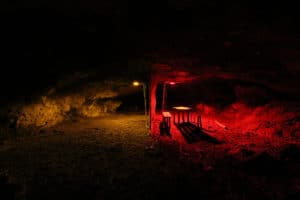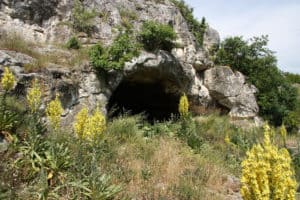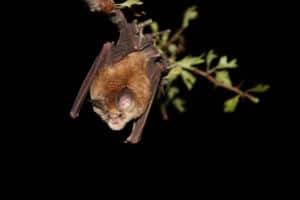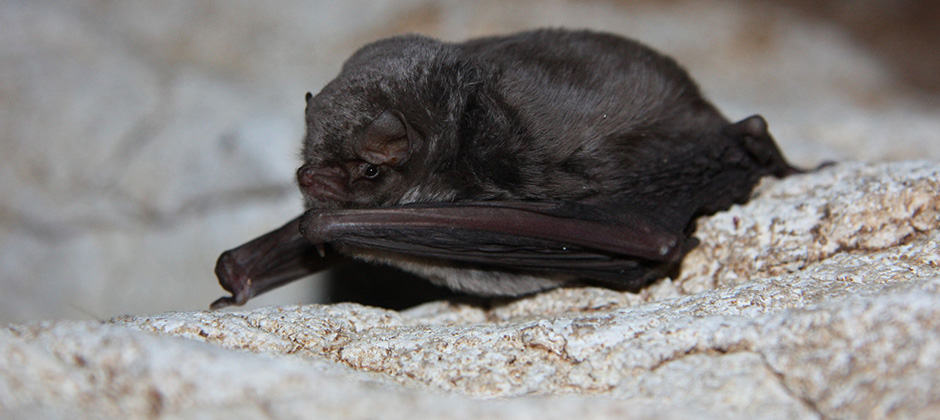Share this article
Bats shy away from artificial cave light
The increasing use of artificial light in and around caves can have a negative effect on cave-dwelling bats.
“[Light] has very traumatic influences on all kinds of wildlife,” said Holger Goerlitz, a research at the Max Planck Institute for Ornithology and one of the senior authors of a study published recently in Global Ecology and Conservation.
Goerlitz and colleagues at the Leibniz Institute for Zoo and Wildlife Research examined the ways that different bat species might react to different types of light.

An artificial bat flight test cave in Bulgaria lit with two types of illumination: amber light on the left and red light on the right. ©Stefan Greif
For the first part of the study, they took captured bats into an artificial cave flight room in Bulgaria in the summer of 2017. They tested long-fingered bats (Myotis capaccinii), Schreiber’s bent-wing bat (Miniopterus schreibersii) under three different light conditions: white, amber and red light — the latter two were assumed to be more bat friendly since they are at the far range of the visible spectrum for humans. The flight room was separated with a divider into two sections each illuminated with different light types — the bats could fly freely between the two areas.

The entrance to the Zorovitza cave in northeastern Bulgaria. ©Stefan Greif
The researchers measured how much time the bats spent in each of the two sections to determine which lighting conditions they preferred. They found that the bats did not prefer amber light over white light, suggesting that amber is not as bat friendly as once thought. Yet, Goerlitz said, “red light was indeed preferred by the bats in the flight room, suggesting that it less problematic.”
They also tried to analyze greater horseshoe bats (Rhinolophus ferrumequinum) and Mediterranean horseshoe bats (Rhinolophus euryale) in the artificial flight testing cave, but these species seemed to be more sensitive, resting repeatedly after a short period of flight.
“Horseshoe bats are very light sensitive. They completely refused to fly in the flight room with any light treatment,” Goerlitz said.
In a second experiment, the researchers put a divider at the exit of a natural bat cave in Bulgaria containing wild populations of Mediterranean horseshoe bats and Mehely’s horseshoe bats (Rhinolophus mehelyi) as well as Schreiber’s bent-wing bats and long-fingered bats.

Mehely’s horseshoe bats were particularly sensitive to light. ©Stefan Greif
They displayed one type of lighting at one side and left the other dark. In every case, the bats were forced to choose one side or the other. They recorded the calls of bats that flew out during three-minute periods during dusk and early evening and counted the numbers of bats left on either side based on their ultrasonic calls.
They found that the all the species tended to avoid light if presented with a dark side. When the researchers lit both sides with different types of light, few bats emerged.
But they found no variation in which lighting types the bats chose. Goerlitz said this shows that all light colors, including red and amber, can have a detrimental effect on bats.
“We need to be very careful with our lighting if we want to protect wildlife,” he said.
The area in northeast Bulgaria where they were experimenting, tourists are drawn to the karst limestone formations. But the area is full of caves that provide important homes for bats. Some of these areas are lit up for tourists, which can have negative effects for the flying mammals, but Goerlitz said that this artificial lighting should be limited at night or at dusk when the bats emerge.
While this study was conducted in Bulgaria, Goerlitz said that there are likely parallels for bats in the Americas — particularly since one of their species was a Myotis, a genus which also has many species in North America.
“It’s an ecologically diverse genus, but as they are nocturnal, we should see the same results in North America,” he said, adding that the species of bats that fly out late during the night rather than early at nightfall are likely to be more light averse wherever they are found.
Header Image:
A Schreiber’s bent-wing bat, one of the species which showed aversion to light in a set of experiments.
©Stefan Greif








